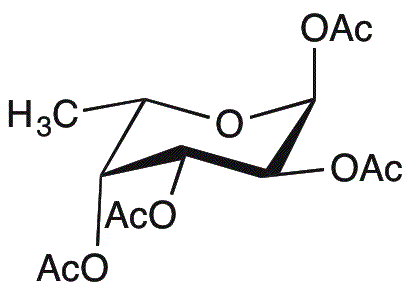1,2,3,4-Tetra-O-acetyl-a-L-fucopyranose is widely utilized in research focused on:
- Glycobiology: This compound serves as a key building block in the synthesis of complex carbohydrates, aiding researchers in studying glycan structures and their biological roles.
- Pharmaceutical Development: It is used in the formulation of drug delivery systems, enhancing the bioavailability of therapeutic agents through improved solubility and stability.
- Food Industry: The compound can be applied as a food additive, contributing to flavor enhancement and preservation, which is essential for maintaining product quality.
- Cosmetics: Its properties make it suitable for use in cosmetic formulations, where it can improve texture and moisturizing effects, appealing to consumers seeking effective skincare solutions.
- Biotechnology: In biotechnological applications, it plays a role in the development of diagnostic tools and assays, facilitating the detection of specific biomolecules in research and clinical settings.
General Information
Properties
Safety and Regulations
Applications
1,2,3,4-Tetra-O-acetyl-a-L-fucopyranose is widely utilized in research focused on:
- Glycobiology: This compound serves as a key building block in the synthesis of complex carbohydrates, aiding researchers in studying glycan structures and their biological roles.
- Pharmaceutical Development: It is used in the formulation of drug delivery systems, enhancing the bioavailability of therapeutic agents through improved solubility and stability.
- Food Industry: The compound can be applied as a food additive, contributing to flavor enhancement and preservation, which is essential for maintaining product quality.
- Cosmetics: Its properties make it suitable for use in cosmetic formulations, where it can improve texture and moisturizing effects, appealing to consumers seeking effective skincare solutions.
- Biotechnology: In biotechnological applications, it plays a role in the development of diagnostic tools and assays, facilitating the detection of specific biomolecules in research and clinical settings.
Documents
Safety Data Sheets (SDS)
The SDS provides comprehensive safety information on handling, storage, and disposal of the product.
Product Specification (PS)
The PS provides a comprehensive breakdown of the product’s properties, including chemical composition, physical state, purity, and storage requirements. It also details acceptable quality ranges and the product's intended applications.
Certificates of Analysis (COA)
Search for Certificates of Analysis (COA) by entering the products Lot Number. Lot and Batch Numbers can be found on a product’s label following the words ‘Lot’ or ‘Batch’.
Numéro de catalogue
Numéro de lot/série
Certificates Of Origin (COO)
This COO confirms the country where the product was manufactured, and also details the materials and components used in it and whether it is derived from natural, synthetic, or other specific sources. This certificate may be required for customs, trade, and regulatory compliance.
Numéro de catalogue
Numéro de lot/série
Safety Data Sheets (SDS)
The SDS provides comprehensive safety information on handling, storage, and disposal of the product.
DownloadProduct Specification (PS)
The PS provides a comprehensive breakdown of the product’s properties, including chemical composition, physical state, purity, and storage requirements. It also details acceptable quality ranges and the product's intended applications.
DownloadCertificates of Analysis (COA)
Search for Certificates of Analysis (COA) by entering the products Lot Number. Lot and Batch Numbers can be found on a product’s label following the words ‘Lot’ or ‘Batch’.
Numéro de catalogue
Numéro de lot/série
Certificates Of Origin (COO)
This COO confirms the country where the product was manufactured, and also details the materials and components used in it and whether it is derived from natural, synthetic, or other specific sources. This certificate may be required for customs, trade, and regulatory compliance.


